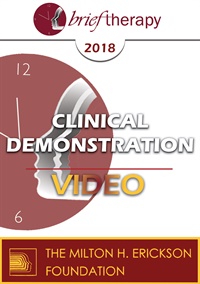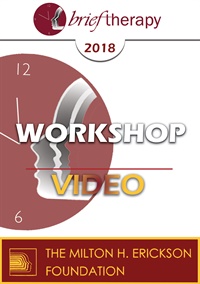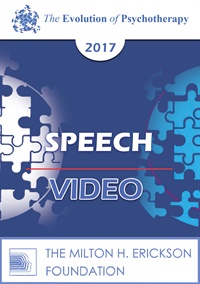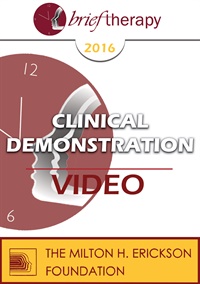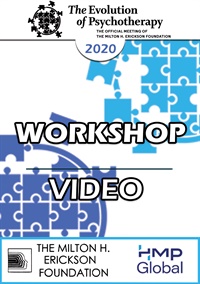
- Average Rating:
- Not yet rated
- Topic Areas:
- Multicultural | Workshops | Psychotherapy | Cultural and Social Contexts | Professional Practice
- Categories:
- Evolution of Psychotherapy | Evolution of Psychotherapy 2020
- Faculty:
- Patricia Arredondo, EdD
- Course Levels:
- Master Degree or Higher in Health-Related Field
- Duration:
- 2 hours
- Format:
- Audio and Video
- Original Program Date:
- Dec 09, 2020
- Short Description:
- This session invites therapists to rethink psychotherapy through a culture-centered lens, starting with their own beliefs, identities, and blind spots. It looks at how culture shapes emotion, communication, power, spirituality, and expectations on both sides of the therapeutic relationship, especially in times of social and political strain. Through clinical reflection and case examples, the talk offers practical ways to work more openly, responsively, and ethically across difference without reducing clients to labels.
- Price:
-
Sale is $29.00
price reduced from Base Price - $59.00

- Average Rating:
- Not yet rated
- Topic Areas:
- Utilization | Clinical Demonstrations | Psychotherapy | Therapist Development | Age Regression | Language of Hypnosis | Therapeutic Relationship
- Bundle(s):
- Art of Psychotherapy - Utilization Series
- Categories:
- Art of Psychotherapy
- Faculty:
- Jeffrey Zeig, PhD
- Course Levels:
- Master Degree or Higher in Health-Related Field
- Duration:
- 2 Hours 15 Minutes
- Format:
- Audio and Video
- Original Program Date:
- Jul 05, 2020
- Short Description:
- Our demonstration subject for session three has two presenting issues - an undercurrent of sadness that seems to be everpresent, and a difficulty communicating about financial situations in her life. Dr. Zeig starts off the session by speaking Spanish, Karina’s native language. This simple technique puts Karina quickly at ease and sets the tone for the session. By inducing a hypnotic state Dr Zeig is able to do a quick age regression, and through utilizing a number of linguistic techniques - recursion, speaking in triplicate, altering tempo and tone of voice - he was able to seed therapeutic goals and create motivation for change.
- Price:
- $79.00 - Base Price

- Average Rating:
- Not yet rated
- Topic Areas:
- Utilization | Clinical Demonstrations | Psychotherapy | Therapist Development | Children and Adolescent Therapy | Interviewing | Relationships | Therapeutic Relationship
- Bundle(s):
- Art of Psychotherapy - Utilization Series
- Categories:
- Art of Psychotherapy
- Faculty:
- Jeffrey Zeig, PhD
- Course Levels:
- Master Degree or Higher in Health-Related Field
- Duration:
- 2 Hours 18 Minutes
- Format:
- Audio and Video
- Original Program Date:
- Jun 28, 2020
- Short Description:
- Demonstration subject Mette is struggling with issues trying to feel an emotional connection to her children. She describes her difficulty with being present for her children, and is looking for guidance. Dr. Zeig exhibits a few simple techniques that help create a powerful therapeutic relationship quickly, through the use of gestures and strategic interview questions. Dr. Zeig is able to utilize this information to create useful suggestions to help Mette with her situation.
- Price:
- $79.00 - Base Price
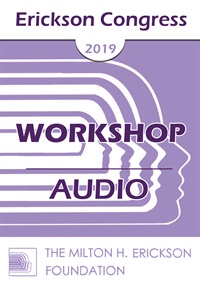
- Average Rating:
- Not yet rated
- Topic Areas:
- Workshops | Trauma | Therapeutic Relationship | Therapist Development
- Categories:
- Erickson Congress | Erickson Congress 2019
- Faculty:
- John Beahrs, MD
- Duration:
- 1 Hour 59 Minutes
- Format:
- Audio Only
- Original Program Date:
- Dec 15, 2019
- Short Description:
- Ratifying victimhood often paradoxically sensitizes to trauma’s effects, and is heavily reinforced socially. Therapists are challenged to help victims restore personal agency and accountability, without denying victimhood. Contracting for roles and boundaries precedes efforts to interdict traumatic re-enactment, redefine personal and social identity, access locus of control, and restore accountability.
- Price:
- $15.00 - Base Price
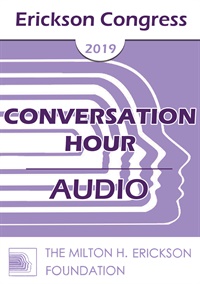
- Average Rating:
- Not yet rated
- Topic Areas:
- Conversation Hours | Therapist Development | Therapeutic Relationship
- Categories:
- Erickson Congress | Erickson Congress 2019
- Faculty:
- Scott Miller, PhD
- Duration:
- 1 Hour 2 Minutes
- Format:
- Audio Only
- Original Program Date:
- Dec 13, 2019
- Short Description:
- In this hour-long discussion, participants will have an opportunity to address questions regarding deliberate practice and their use of routine outcome measures in clinical practice.
- Price:
- $15.00 - Base Price
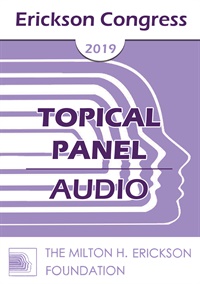
- Average Rating:
- Not yet rated
- Topic Areas:
- Workshops | Dissociation | Trauma | Hypnosis | Therapeutic Relationship
- Categories:
- Erickson Congress | Erickson Congress 2019
- Faculty:
- Camillo Loriedo, MD, PhD
- Duration:
- 1 Hour 54 Minutes
- Format:
- Audio Only
- Original Program Date:
- Dec 13, 2019
- Short Description:
- Dissociation can be described as the failure to integrate information and self-attributions that should ordinarily be integrated, and as alterations of consciousness characterized by a sense of detachment from the self and/or the environment. The strong connection between Hypnosis and Dissociation is known since the time of Pierre Janet's pioneer work. Dissociative hypnotic intervention demonstrated to be very useful in treating pain, anxiety disorders and many other conditions.
- Price:
- $15.00 - Base Price
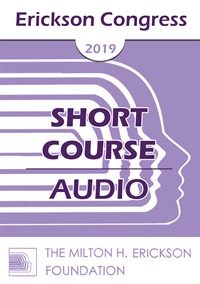
- Average Rating:
- Not yet rated
- Topic Areas:
- Short Courses | Depression | Trauma | Seeding | Therapeutic Relationship
- Categories:
- Erickson Congress | Erickson Congress 2019
- Faculty:
- Robert Wubbolding, EdD
- Duration:
- 1 Hour 24 Minutes
- Format:
- Audio Only
- Original Program Date:
- Dec 12, 2019
- Short Description:
- The American novelist William Faulkner stated, "The Past is never dead. In fact, it is not even past." This presentation emphasizes the unconventional use of reality therapy that connects the past with the presents by helping clients realize that their current behaviors are normal responses to abnormal situations that they have experienced. It also operationalizes the Ericksonian principle: "The solution often appears unrelated to the problem."
- Price:
- $15.00 - Base Price
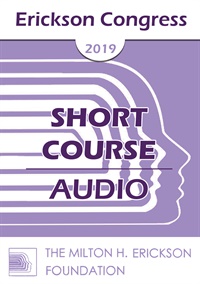
- Average Rating:
- Not yet rated
- Topic Areas:
- Short Courses | Relationships | Ericksonian Hypnosis and Therapy Techniques | Therapeutic Relationship
- Categories:
- Erickson Congress | Erickson Congress 2019
- Faculty:
- Kevin Hall, MSc
- Duration:
- 1 Hour 26 Minutes
- Format:
- Audio Only
- Original Program Date:
- Dec 12, 2019
- Short Description:
- Warmth is essential to life itself and we have therefore been attracted to it since the beginning of time. Conversely cold, the absence of warmth is associated with conditions of a more precarious nature such as scarcity, isolation or even demise. The association also seems to hold true for human relationships: people who are able to signify the concept of warmth in the way they relate to others appear socially competent, trustworthy and charismatic. The presence of warmth positively enhances attachment experiences and therefore moments of significant emotional connection.
- Price:
- $15.00 - Base Price
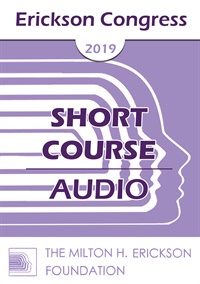
- Average Rating:
- Not yet rated
- Topic Areas:
- Short Courses | Pain and Healing | Therapeutic Relationship | Ericksonian Hypnosis and Therapy Techniques
- Categories:
- Erickson Congress | Erickson Congress 2019
- Faculty:
- Virgil Hayes, DO
- Duration:
- 1 Hour 27 Minutes
- Format:
- Audio Only
- Original Program Date:
- Dec 12, 2019
- Short Description:
- Chronic pain is frequently encountered by healthcare professionals. The current treatment is primarily pharmaceutical intervention with Opioids or NSAIDS that create new problems and address a limited part of the pain. Pain, whether physical or mental/emotional, tends to be experienced as one. Anticipated pain and memories of past painful incidents also contribute to the experience of pain.
- Price:
- $15.00 - Base Price
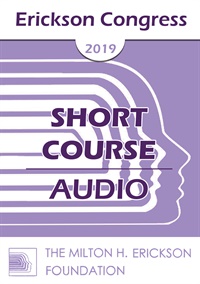
- Average Rating:
- Not yet rated
- Topic Areas:
- Short Courses | Art and Creativity | Hypnotherapy | Psychotherapy | Therapeutic Relationship | Therapist Development
- Categories:
- Erickson Congress | Erickson Congress 2019
- Faculty:
- Richard Hill, MBMSc, MEd, MA
- Duration:
- 1 Hour 30 Minutes
- Format:
- Audio Only
- Original Program Date:
- Dec 12, 2019
- Short Description:
- Hypnotherapy and psychotherapy have been developing over time through various phases. Directive therapies with an intervention orientation have shifted over the years to suggestive and client centered approaches. More recently both research and practice has opened our minds to relational and responsive approaches. The concept of “client responsiveness” is discussed in my book with Ernest Rossi, The Practitioner’s Guide to Mirroring Hands.
- Price:
- $15.00 - Base Price
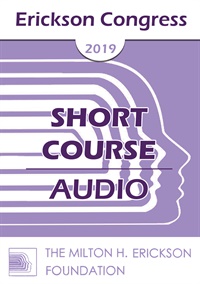
- Average Rating:
- Not yet rated
- Topic Areas:
- Short Courses | Therapeutic Relationship | Therapist Development | Trance | Resistance
- Categories:
- Erickson Congress | Erickson Congress 2019
- Faculty:
- Ilene Wolf, MA, LMFT
- Duration:
- 1 Hour 19 Minutes
- Format:
- Audio Only
- Original Program Date:
- Dec 12, 2019
- Short Description:
- This interactive workshop utilizes the group to teach and apply highly effective trance methods, combined with evidenced-based research from Stanford, and drama therapy action methods, (i.e. sociometric scaling, role reversal to increase empathy and the empty chair), to address clients’ unwillingness to give up defensiveness, blame and other relationship problems.
- Price:
- $15.00 - Base Price
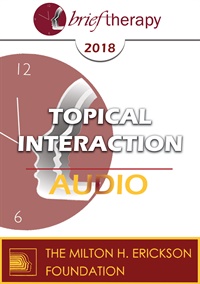
- Average Rating:
- Not yet rated
- Topic Areas:
- Topical Interactions | Feedback Informed Treatment (FIT) | Tailoring | Relationships | Therapeutic Relationship | Therapist Development
- Categories:
- Brief Therapy Conference | Brief Therapy Conference 2018
- Faculty:
- Scott Miller, PhD
- Duration:
- 57:17
- Format:
- Audio Only
- Original Program Date:
- Dec 08, 2018
- Short Description:
- Available evidence indicates that the effectiveness of psychotherapy has not improved despite 100 years of theorizing and research. What would help? Not learning a new model of therapy or the “latest” so-called “evidence-based” treatment approach. A simple, valid, and reliable alternative exists for maximizing the effectiveness and efficiency of treatment based on using ongoing feedback to empirically tailor services to the individual client needs and characteristics. Research from multiple randomized clinical trials documents that this simple, transtheoretical approach as much as doubles the effectiveness of treatment while simultaneously reducing costs, drop-out rates and deterioration. At this "Topical Interaction," participants will have a chance to address any practical issues, questions or challenges associated with incorporating outcome and alliance measures into their practice.
- Price:
- $15.00 - Base Price
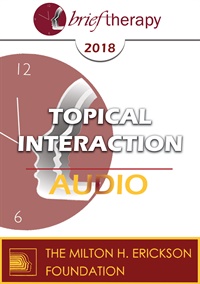
- Average Rating:
- Not yet rated
- Topic Areas:
- Topical Interactions | Psychotherapy | Brief Therapy | Therapeutic Relationship | Therapist Development
- Categories:
- Brief Therapy Conference | Brief Therapy Conference 2018
- Faculty:
- Stephen Gilligan, PhD
- Duration:
- 1:04:33
- Format:
- Audio Only
- Original Program Date:
- Dec 08, 2018
- Short Description:
- Every meaningful therapy conversation includes a significant presence of difficult emotions--symptoms, responses, anger, fear, etc. We will have a conversation about how to skillfully welcome and utilize such negative experiences as integral parts of a successful, creative therapy.
- Price:
- $15.00 - Base Price
Credit available - Click Here for more information
- Average Rating:
- Not yet rated
- Topic Areas:
- Clinical Demonstrations | Brief Therapy | Ericksonian Hypnosis and Therapy Techniques | Hypnosis | Naturalistic | Therapeutic Relationship | Couples Therapy
- Bundle(s):
- Learning Track - Using Hypnosis
- Categories:
- Brief Therapy Conference | Brief Therapy Conference 2018 | Online Continuing Education
- Faculty:
- Camillo Loriedo, MD, PhD
- Course Levels:
- Master Degree or Higher in Health-Related Field
- Duration:
- 1:03:30
- Format:
- Audio and Video
- Original Program Date:
- Dec 08, 2018
- Short Description:
- As suggested by Milton Erickson, naturalistic hypnosis seems to be one of the best way of utilizing couple’s resources. Frequently couples fail in reaching a deep mutual exchange and complain of being unable to satisfy their needs for intimacy. Hypnotic experience seems to produce by itself a deep contact that rarely develops in their habitual patterns. Specific couple’s responses to hypnotic induction that can be utilized to produce contact and intimacy will be demonstrated. In some other cases couples are caught by conflicts they are unable to solve. A couples hypnotherapist can extend to both couple members rapport, and succeed in obtaining a special relationship that produces more syntonic and attuned behaviors, in which conflict intensity decreases and a greater ability to listen to each other and negotiate con
- Price:
-
Sale is $29.00
price reduced from Base Price - $59.00
Credit available - Click Here for more information
- Average Rating:
- Not yet rated
- Topic Areas:
- Workshops | Brief Therapy | Therapeutic Relationship | Therapist Development | Neuroscience
- Categories:
- Brief Therapy Conference | Brief Therapy Conference 2018 | Online Continuing Education
- Faculty:
- Stephen Gilligan, PhD
- Course Levels:
- Master Degree or Higher in Health-Related Field
- Duration:
- 2:00:04
- Format:
- Audio and Video
- Original Program Date:
- Dec 07, 2018
- Short Description:
- By virtue of our "mirror neurons", it is impossible for therapists to not be deeply touched by client's experiences. We will explore how this can be done skillfully and safely, thereby opening multiple pathways of feedback, compassion, and technical competencies. Special attention will be to mindful activation of the three "minds" of somatic, cognitive, and relational field intelligence, again with the intent of creating a deep and sophisticated conversational connection.
- Price:
-
Sale is $29.00
price reduced from Base Price - $59.00
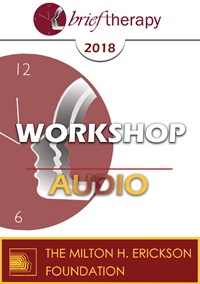
- Average Rating:
- Not yet rated
- Topic Areas:
- Workshops | Brief Therapy | Therapeutic Relationship | Therapist Development
- Categories:
- Brief Therapy Conference | Brief Therapy Conference 2018
- Faculty:
- Bob Bertolino, PhD
- Duration:
- 1:59:16
- Format:
- Audio Only
- Original Program Date:
- Dec 07, 2018
- Short Description:
- Effective clinicians draw on various sources of external knowledge to inform practice. One source can be found in the models of today which are popularized in numerous books and training opportunities. A second source is comprised of discoveries in fields such as medicine, education, philosophy, art, spirituality, and the sciences. Although these two sources provide a wealth of knowledge, effective practitioners also rely on a third source that not only serves as a foundation for practice but also informs treatment strategies. The third source is rooted in traditional psychotherapy theories and the contributions of early pioneers.
- Price:
- $15.00 - Base Price
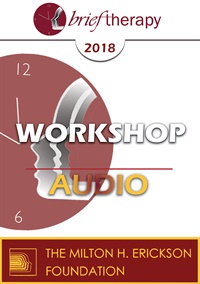
- Average Rating:
- Not yet rated
- Topic Areas:
- Workshops | Anxiety | Obsessive Compulsive Disorder (OCD)
- Categories:
- Brief Therapy Conference | Brief Therapy Conference 2018
- Faculty:
- Reid Wilson, PhD
- Duration:
- 2:01:25
- Format:
- Audio Only
- Original Program Date:
- Dec 07, 2018
- Short Description:
- This session focuses on managing anxiety in the moment through strategic, fast-acting interventions. Reid Wilson shares tools for embracing doubt, engaging working memory, and using self-talk to shift responses to anxiety. Highlights include personifying the disorder, seeking out distress, and building trust in the therapeutic process. A case study illustrates how rapid change is possible with focused techniques. Includes practical resources for both clients and clinicians.
- Price:
- $15.00 - Base Price

- Average Rating:
- Not yet rated
- Topic Areas:
- Conversation Hours | Virginia Satir | Psychotherapy | Therapist Development | Therapeutic Relationship
- Categories:
- Evolution of Psychotherapy | Evolution of Psychotherapy 2017
- Faculty:
- Maria Gomori, MSW, PhD
- Course Levels:
- Master Degree or Higher in Health-Related Field
- Duration:
- 59:34
- Format:
- Audio Only
- Original Program Date:
- Dec 15, 2017
- Short Description:
- The Use of Self of the Therapist is the most important part of the therapeutic relationship.
- Price:
- $15.00 - Base Price
Credit available - Click Here for more information
- Average Rating:
- Not yet rated
- Topic Areas:
- Speeches | Interviewing | Motivation | Therapeutic Relationship
- Categories:
- Evolution of Psychotherapy | Evolution of Psychotherapy 2017 | Online Continuing Education
- Faculty:
- William Miller, PhD
- Course Levels:
- Master Degree or Higher in Health-Related Field
- Duration:
- 55:47
- Format:
- Audio and Video
- Original Program Date:
- Dec 15, 2017
- Short Description:
- The clinical method of motivational interviewing (MI) evolved from the person-centered approach of Carl Rogers, maintaining his pioneering commitment to the scientific study of therapeutic processes and outcomes. The original developer of MI will summarize the development of this method, its linkage to Rogers, and research on its therapeutic processes, outcomes, and training.
- Price:
-
Sale is $29.00
price reduced from Base Price - $59.00

- Average Rating:
- Not yet rated
- Topic Areas:
- Great Debates | Transpersonal | Psychotherapy | Relationships | Therapeutic Relationship
- Categories:
- Evolution of Psychotherapy | Evolution of Psychotherapy 2017
- Faculty:
- Jean Houston, PhD | Erving Polster, PhD
- Duration:
- 1:27:19
- Format:
- Audio Only
- Original Program Date:
- Dec 14, 2017
- Short Description:
- There is a professionally familiar dichotomy between the experience of an actual person to person relationship, on the one hand, and the transpersonal expansion. The latter is often given a special place in the therapeutic repertoire but, in actuality, they are overlapping experiences, Drs. Houston and Polster will each tell how these perspectives enter into their work, with an accompanying discussion.
- Price:
- $15.00 - Base Price
Credit available - Click Here for more information
- Average Rating:
- Not yet rated
- Topic Areas:
- Clinical Demonstrations with Discussant | Gestalt | Somatic Experiences | Psychotherapy | Relationships | Therapeutic Relationship
- Bundle(s):
- Learning Track - EP17 Gestalt Stream
- Categories:
- Evolution of Psychotherapy | Evolution of Psychotherapy 2017 | Evolution of Psychotherapy Psychotherapy Learning Track | Online Continuing Education
- Faculty:
- Erving Polster, PhD | Peter Levine, PhD
- Course Levels:
- Master Degree or Higher in Health-Related Field
- Duration:
- 1:25:10
- Format:
- Audio and Video
- Original Program Date:
- Dec 14, 2017
- Short Description:
- Personal disturbance is accompanied by feelings of disconnection within one’s self and with others. Reconnection is accomplished when the therapist guides the patient into a fertile conversational stream - a moment to moment impetus toward personal resolution.
- Price:
-
Sale is $29.00
price reduced from Base Price - $59.00

- Average Rating:
- Not yet rated
- Topic Areas:
- Workshops | Brief Therapy | Therapeutic Relationship | Therapist Development
- Categories:
- Brief Therapy Conference | Brief Therapy Conference 2016
- Faculty:
- Bill O'Hanlon, MS
- Duration:
- 2:47:28
- Format:
- Audio Only
- Original Program Date:
- Dec 11, 2016
- Short Description:
- There are features that most brief therapies share. Dropping all the theoretical jargon, it becomes very simple. This presentation will provide a simple way to get therapy started on the right foot so it ends well and as quickly as possible.
- Price:
- $15.00 - Base Price

- Average Rating:
- Not yet rated
- Topic Areas:
- Psychotherapy | Workshops | Attunement | Therapeutic Relationship | Brief Therapy
- Categories:
- Brief Therapy Conference | Brief Therapy Conference 2016
- Faculty:
- Jeffrey Zeig, PhD
- Duration:
- 2:31:48
- Format:
- Audio Only
- Original Program Date:
- Dec 11, 2016
- Short Description:
- Attunement can be considered the deepest level of rapport, a foundation of empathy. We will learn how to attune to affect, behavior, cognition, attitude, perception, and relationship patterns —even how to attune to the preconscious associations that drive behavior. A precursor to every intervention, attunement will be described from the perspective of hypnosis, psychotherapy, and social psychology. Clinical applications will be demonstrated and discussed. Includes small-group practice exercises.
- Price:
- $15.00 - Base Price
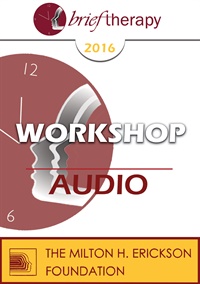
- Average Rating:
- Not yet rated
- Topic Areas:
- Psychology | Workshops | Brief Therapy | Therapeutic Relationship | Relationships
- Categories:
- Brief Therapy Conference | Brief Therapy Conference 2016
- Faculty:
- Bill O'Hanlon, MS
- Duration:
- 2:17:22
- Format:
- Audio Only
- Original Program Date:
- Dec 11, 2016
- Short Description:
- In brief therapy, we have to be better than long-term therapists in getting people to change and cooperate with treatment. Recent research from social psychology, behavioral economics and the new brain science show three powerful principles for being persuasive. Why do marketers know all this and most therapists do not? Come and learn how to be at least as persuasive as marketers.
- Price:
- $15.00 - Base Price
- Average Rating:
- Not yet rated
- Topic Areas:
- Clinical Demonstrations | Hypnosis | Ericksonian Hypnosis and Therapy Techniques
- Categories:
- Brief Therapy Conference | Brief Therapy Conference 2016
- Faculty:
- Michael Yapko, PhD
- Course Levels:
- Master Degree or Higher in Health-Related Field
- Duration:
- 59:00
- Format:
- Audio and Video
- Original Program Date:
- Dec 10, 2016
- Short Description:
- In this demonstration, hypnosis becomes a framework for making difficult life decisions. A volunteer weighing questions of aging, family, and independence experiences how shifting from fear-based thinking to strength-based clarity can open new options. Through metaphors, imagery, and experiential learning, the session shows how hypnosis helps clients find grounded confidence in their choices and greater comfort with uncertainty.
- Price:
-
Sale is $29.00
price reduced from Base Price - $59.00


